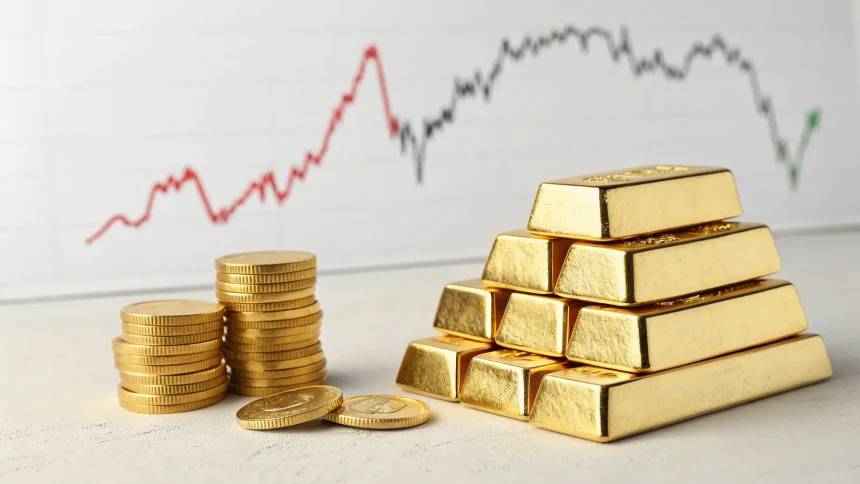As investors scan markets for signs that inflation is cooling or flaring, gold is again in the spotlight as a possible shield for rising prices. The metal’s reputation as a safe store of value is long-standing, but its day-to-day moves often surprise those expecting a simple link to inflation. With households and institutions weighing how to protect purchasing power, the question is whether gold can still do the job.
“Trends in gold prices could indicate whether the asset can protect against inflation. Here’s a look at how the precious metal is doing today.”
Why Gold and Inflation Are So Often Linked
Gold has been tied to money for centuries. Many countries once backed their currencies with gold. That history feeds the belief that the metal should hold value when money loses it.
Inflation erodes cash. Gold is scarce and does not degrade, so it appeals to investors seeking stability. Yet market pricing depends on more than inflation alone. Interest rates, the strength of the U.S. dollar, and investor sentiment can pull prices in different directions.
Academic work offers a mixed view. Research by Claude Erb and Campbell Harvey found that gold tracks inflation over very long horizons, but short- and medium-term results vary widely. That helps explain why the metal at times lags even when prices in the economy rise.
What Usually Drives Gold Prices
Several forces, not just inflation, tend to influence moves in gold.
- Real interest rates: Lower inflation-adjusted bond yields make gold, which pays no income, more attractive.
- U.S. dollar: A weaker dollar often lifts gold as it becomes cheaper for non-U.S. buyers.
- Central bank demand: Reserve managers buying gold for diversification can support prices.
- Investment flows: Exchange-traded funds can magnify moves as assets enter or exit.
- Geopolitical risk: Conflict or uncertainty can push investors into perceived safe assets.
How Gold Has Performed in High-Inflation Periods
History shows gold can shine in some inflationary bursts but not all. During the 1970s, when inflation ran hot for years, gold delivered strong gains as real rates fell and confidence in paper money weakened. That period shaped gold’s inflation-hedge image.
The picture was different in parts of the 1980s and 1990s. As central banks beat back inflation and real rates rose, gold struggled. More recently, during the global financial crisis, gold advanced as rates collapsed and fear surged. In 2020, the pandemic shock and aggressive policy easing helped push gold higher, even as inflation initially dropped before rebounding.
These episodes point to a pattern: gold tends to do well when real yields are falling or deeply negative, and when trust in policy or markets is under stress. When inflation is high but real yields rise, the metal can lag.
Voices From the Market
Market participants often stress the need to match gold’s role to a portfolio’s goals. One common view is that gold is less a precise hedge for monthly inflation and more a hedge against extreme outcomes—policy errors, currency shocks, or geopolitical crises.
Some strategists argue that exposure works best as a long-term diversifier. Others caution against relying on gold alone, noting that commodities, inflation-linked bonds, and select equities can also help protect purchasing power.
What to Watch Next
Investors looking for clues on gold’s path focus on a few signals. Real yields on U.S. Treasury Inflation-Protected Securities point to the opportunity cost of holding gold. The dollar’s trend affects global demand. Changes in central bank reserves, reported quarterly, can shift the balance between buyers and sellers. Finally, equity volatility and geopolitical headlines can drive short bursts of demand.
Positioning also matters. Large inflows into gold-backed funds can push prices beyond fundamental drivers, setting up reversals if sentiment turns. Conversely, steady central bank buying can add a floor even when investment flows are weak.
How to Think About Gold in a Portfolio
Gold can help diversify risk, especially during stress. But it is not a guaranteed shield against each rise in consumer prices. The evidence suggests it is most effective over long stretches and in episodes of strong policy or currency uncertainty.
Investors may consider sizing allocations modestly and pairing gold with assets that respond more directly to inflation, such as inflation-linked bonds or select commodity exposures. That approach can reduce reliance on a single driver and smooth results.
Gold’s appeal endures because it offers a form of insurance when confidence wobbles. As inflation, policy, and geopolitical forces shift, the metal will likely remain a barometer for fear and faith in money. For now, the prudent stance is clear: watch real yields, the dollar, and central bank demand—and treat gold as a strategic diversifier rather than a one-for-one inflation hedge.







